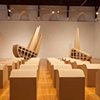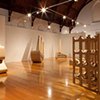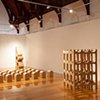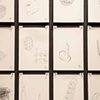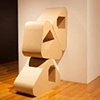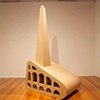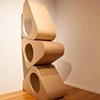
Transit
Transit
2013 Solo Commission Exhibition
24 August - 22 September
Talking to Ross Byers about his art is like taking a journey along a path where every divergence offers the promise of something more, of a transition from one level of understanding to another. He talks around his work, rather than directly to it. Listen, as the layers build, tales are told, and a wider narrative develops. Watch, as romantic flights are grounded in pragmatic action, imagination in craft.
Byers is, as he himself has observed, a man of stories.
Those who see in Byers’ eccentric cardboard shapes something of Dr Seuss’s The Cat in the Hat can be assured that the dynamic objects in this collection owe something to that childhood character. The use of cardboard only adds to the ramshackle madness of form, seemingly always in movement, a wonderfully illogical juxtaposition of the precision of the mechanical with the temporary and the vernacular.
The idea of play is important to Byers’ work. Play moves the functional processes of craft into the realm of art. In this body of work, Byers responds to both childhood memory and to the childlike quality that is inherent in play. But the work, like his stories, is multi-layered. Byers’ assertion that ‘Before materiality comes thought’, suggests a process that recalls the ideas of Richard Sennett (The Craftsman, 2008), who wrote of the abilities required of a craftsman: making a matter concrete, reflecting on its qualities and expanding its sense.
Drawing is at the core of Byers’ creativity and allows the transition of ideas and materials into form. The process commences when he attempts to catch the ethereal, materialising his thoughts in his journals – each drawing having the potential to become the precursor to a sculptural object. Against this apparently intuitive yet deliberate thinking, is a calling up of craft, through which the initial images are interpreted as engineering drawings in preparation for making. Finally, when a sculptural form has been completed, a drawing is made that captures its new existence, the outcome of thinking, drawing, making, of work certainly but also of play.
The ritual of thinking, planning, drawing, cutting and assembling is one of simplicity, of paring back. It is also something that Byers applies to his own life, which is irrevocably his art and remains in a perpetually transitory state. The need for a stabilising ritual within this constant movement might have some origins in an intense, perhaps obsessive childhood experience of religion, a sparseness of external form that belies the passions within. The gallery-as-container for forms restrained by a ritualistic practice (thinking, delineating,
incising and repeating) is a familiar space, where each component is observed in a childlike way – not simply reiterated and fragmented but now playful and relational. Ritual is materialised in towers and buttresses, perpendiculars and curves, each reduced to what is necessary to fulfil a function.
So the Gallery space, with its ecclesiastical origins, cradles Ross Byers’ individual forms which, in turn, complement the architecture. Components talk to each other, recognise familial connections and play on formal relationships. In their simplicity life, art and architecture become family, each extending the hand of welcome and of making.
Dr Deb Malor, 2013
2013 Solo Commission Exhibition
24 August - 22 September
Talking to Ross Byers about his art is like taking a journey along a path where every divergence offers the promise of something more, of a transition from one level of understanding to another. He talks around his work, rather than directly to it. Listen, as the layers build, tales are told, and a wider narrative develops. Watch, as romantic flights are grounded in pragmatic action, imagination in craft.
Byers is, as he himself has observed, a man of stories.
Those who see in Byers’ eccentric cardboard shapes something of Dr Seuss’s The Cat in the Hat can be assured that the dynamic objects in this collection owe something to that childhood character. The use of cardboard only adds to the ramshackle madness of form, seemingly always in movement, a wonderfully illogical juxtaposition of the precision of the mechanical with the temporary and the vernacular.
The idea of play is important to Byers’ work. Play moves the functional processes of craft into the realm of art. In this body of work, Byers responds to both childhood memory and to the childlike quality that is inherent in play. But the work, like his stories, is multi-layered. Byers’ assertion that ‘Before materiality comes thought’, suggests a process that recalls the ideas of Richard Sennett (The Craftsman, 2008), who wrote of the abilities required of a craftsman: making a matter concrete, reflecting on its qualities and expanding its sense.
Drawing is at the core of Byers’ creativity and allows the transition of ideas and materials into form. The process commences when he attempts to catch the ethereal, materialising his thoughts in his journals – each drawing having the potential to become the precursor to a sculptural object. Against this apparently intuitive yet deliberate thinking, is a calling up of craft, through which the initial images are interpreted as engineering drawings in preparation for making. Finally, when a sculptural form has been completed, a drawing is made that captures its new existence, the outcome of thinking, drawing, making, of work certainly but also of play.
The ritual of thinking, planning, drawing, cutting and assembling is one of simplicity, of paring back. It is also something that Byers applies to his own life, which is irrevocably his art and remains in a perpetually transitory state. The need for a stabilising ritual within this constant movement might have some origins in an intense, perhaps obsessive childhood experience of religion, a sparseness of external form that belies the passions within. The gallery-as-container for forms restrained by a ritualistic practice (thinking, delineating,
incising and repeating) is a familiar space, where each component is observed in a childlike way – not simply reiterated and fragmented but now playful and relational. Ritual is materialised in towers and buttresses, perpendiculars and curves, each reduced to what is necessary to fulfil a function.
So the Gallery space, with its ecclesiastical origins, cradles Ross Byers’ individual forms which, in turn, complement the architecture. Components talk to each other, recognise familial connections and play on formal relationships. In their simplicity life, art and architecture become family, each extending the hand of welcome and of making.
Dr Deb Malor, 2013






